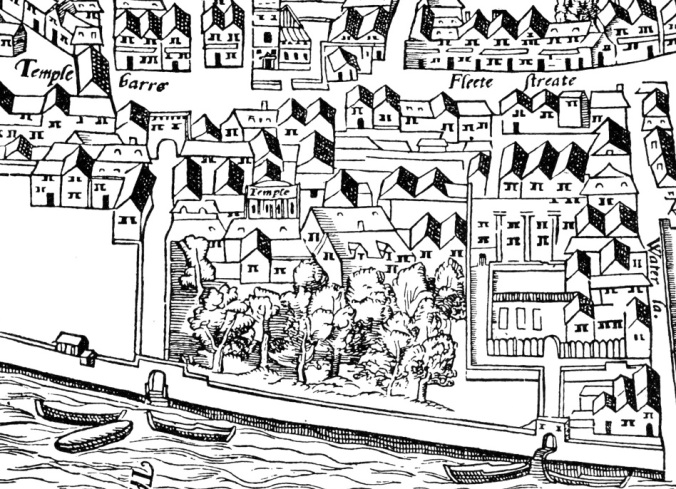
Inner Temple and Fleet Street in 1561
There have been calls in recent years to do away with the split legal profession. Proposals for a fused legal profession come with regularity, and attempts have been made made to abolish wigs and gowns.
The English bar of the 1450s is a profession that may be eminently relatable in its attitudes and habits to the modern practitioner. In that vein, I felt a ‘day in the life’ might be interesting insofar as it exhibits the great antiquity of, and continuity in, the English bar and conveys a sense of the uniqueness of its traditions and practices.
Digs
Our barrister is an apprentice-at-law, the medieval equivalent of junior counsel. The medieval equivalent of senior counsel were the serjeants-at-law. There may have been approximately 1,000 apprentices across the four Inns, while there were often as few as half a dozen serjeants and sometimes even as few as three. An apprentice might also be a reader or bencher of his Inn.
In theory, the serjeants had exclusive rights of audience in the Court of Common Pleas, the premier civil court of the realm in which was heard real actions and pleas between subjects. In reality, it seems that apprentices did sometimes plead causes in the Common Pleas and given the court saw around 10,000 cases per year in the 1450s, it seems unlikely a half-dozen men could have appeared in every one.
Our barrister lives in chambers at the Temple during the legal term, while his wife lives in the country at his ancestral manor. Women are not allowed in chambers although it is common enough for members to sneak a lady friend into their room, and to pay a fine if caught. In fact, the records of the Inns register countless fines paid out for infractions; fornicating, blaspheming, gambling with dice, stabbing each other with daggers. In spite of the rambunctious nature of the medieval bar, the Inns are characterised by a great sense of camaraderie. The Temple was described in Elizabethan times thusly;
A place wherein are store gentlemen of the whole realm that repair thither to rule and obey by law, to use all other exercises of body and mind whereunto nature most aptly serveth to adorn by speaking, countenance, gesture and use of apparel, whereby amity is obtained and continued, that gentlemen of all countries in their young years, nourished together in one place with such comely order and daily conference, are knit together by continual acquaintance in such unity of minds and manners as lightly never after is severed.
Chambers is two rooms that our barrister shares with a fellow reader and a pupil; enough space for writing desks, a couple of chairs, straw mattresses, a small fireplace and storage space for documents.
His day begins before dawn and a tap on the window from a professional ‘knocker-up’, or human alarm-clock, is his wake-up call. The central law courts at Westminster Hall sit between 8am and 11am, Monday to Saturday, during the legal term. One is not given a particular time for a hearing; every case is a ‘floater’ so it pays to get there early.
Our barrister loads up his pupil with papers, quills and ink and they walk down to Temple wharf and engage a boatman to take them up-river to the Palace of Westminster. A short journey up-river is far preferable to walking or riding through the filthy, overcrowded streets.
Westminster
Landing at the Palace of Westminster, our barrister would encounter not the singular, neo-Gothic behemoth standing there today but a rambling precinct of buildings of various vintages. The palace is the nerve centre of the medieval English state; the location of the central law courts, a meeting place for parliament, an archive, a royal palace and a storehouse for treasure.

The palace was focused around Westminster Hall, the home of the courts of King’s Bench, Common Pleas and Chancery. In an adjoining building was the Court of Exchequer and the Exchequer Chamber, the latter being a court of appeal. Adjacent to the Hall was the Painted Chamber, a throne-room in which the House of Lords met during parliaments. The House of Commons had no permanent home as yet but would often meet in the Chapter House of Westminster Abbey.
The courts themselves were situated inside the hall on raised wooden platforms. The southern end of the hall was shared by the King’s Bench and Court of Chancery, while the Common Pleas was situated on the western wall towards the northern end of the hall.
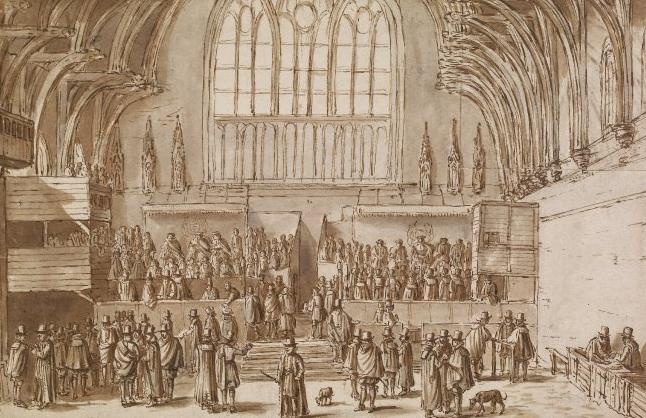
Along the sides of the hall were vendors selling stationery, legal texts, snacks and ale. The hall could be a cold and draughty place in late Michaelmas and early Hilary, with heat being provided by a number of small coal braziers.
In the morning during legal term, Westminster Hall was a very busy, and noisy, place. Litigants, attorneys and barristers would congregate around the bar of the court waiting for their case to be called. There would also be numerous law students in attendance, for the direct observation of court proceedings was considered to be a most efficacious mode of teaching the practice of law.
The judges sat on a raised platform with their backs to the wall. At their feet were the clerks of the court; they would record the pleas for the plea rolls and legal argument for the Year Books (medieval law reports). Order would be kept by ushers armed with white staffs.
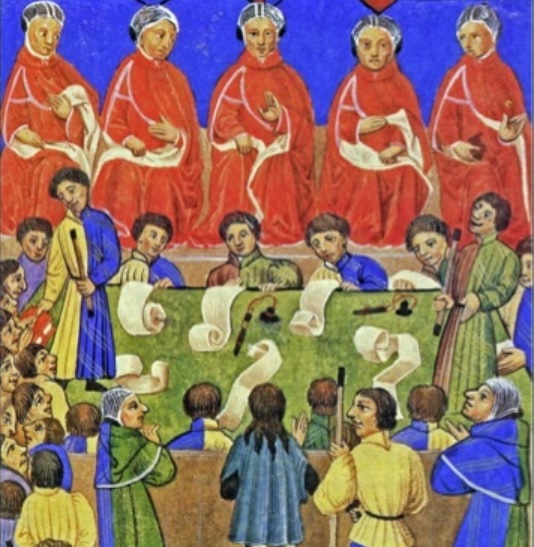
The white-capped fellows standing at the bar are serjeants-at-law; the spectators at left are law students. The court usher on top of the clerks’ table stands ready to give them a crack over the chops if they misbehave
Our barrister meets with his first client for the day, a prosperous merchant of Guildford who is the plaintiff in a claim of replevin (an action to recover personal property). The defendant is the sub-sheriff of Surrey whom the plaintiff claims has stolen his sheep. The barrister is to represent his client in a preliminary hearing.
This case management hearing is to resolve any issues of law and secure ‘joinder of issue’ so that an issue of fact can be presented to a jury to resolve (trial at nisi prius). That jury trial would then occur in the county court proximate to the controversy, presided over by a judge or judges of the King’s Bench, Common Pleas or Exchequer on circuit.
Some legal academics believe that the medieval barrister’s practice may have been “high-volume / low-fee”. Preliminary hearings at Westminster Hall primarily determined questions of law and could be highly abstract. In preparing for a case, a barrister might spend comparatively little time familiarising himself with the particular facts of his cases and instead focus on building and maintaining his knowledge of caselaw and hypothetical scenarios, and honing his ability to think on his feet and respond to unexpected or novel legal argument. His aim was to ensure that the question the court tendered to the jury was that which was most favourable to the client’s prospects. A 15th-century barrister practising at Westminster Hall might plead causes at the bar day-in, day-out without often seeing a verdict; that could be left to a provincial attorney who would take responsibility for the case once it was referred back to the county court for jury trial at nisi prius.
In the case before them, the defendant sub-sheriff’s counsel argues that two knights were elected to the House of Commons to represent Surrey in the recent parliament, that these knights are entitled by statute to recover their travel and subsistence expenses through an assessment levied on the county and that Guildford’s contribution was 40 shillings. The sheep were taken and sold to cover part of Guildford’s contribution.
Our barrister replies that the sub-sheriff still has the sheep, thus they cannot have been taken for the purposes of sale. The justices are against the plaintiff on this point; it is not a good ‘replication’ to the sub-sheriff’s defence as it does not go to the original issue of liability.
Our barrister then argues that the sheep were taken to satisfy the nonpayment of the levy by others, and not by him. He further argues that Guildford is an ancient borough that sends its own burgess to the House of Commons, and thus he cannot be chargeable for the parliamentary expenses of knights who are not his member of parliament.
The justices reply that statute gives the king the power to take this property to meet the expenses of knights of the shire, and that whatever is within the power of the king is within the power of the sheriff and his agents. The plaintiff’s remedy is, therefore, by way of petition to the king’s council or to parliament.
Our barrister has unfortunately not been able to secure a win for his client; the writ abates and his client’s case ends at this preliminary hearing without proceeding to a jury trial.
Exchequer Chamber
Our barrister moves on to his second case of the day, a matter of exceptional legal importance to be heard in the Exchequer Chamber. He is representing Simon Eyre, a pawnbroker of the City of London, the defendant in a case before the Court of Exchequer that was removed to the Exchequer Chamber in light of its legal implications.
An ‘information’ was laid before the Court of Exchequer by the Keeper of the King’s Jewels alleging that certain of the king’s jewels that had been in the Keeper’s custody came into the possession of the defendant. Process issued against Mr Eyre to answer this information and justify his possession of the jewels, or otherwise return them to the king. The implication is that Mr Eyre has received stolen property.
Our barrister notes that an enormous amount of legal firepower has been assembled by the king; four king’s serjeants (medieval Treasury devils) and the Attorney-General have appeared to argue the king’s case.
In response to the information, Mr Eyre pleads that it is a custom of the City of London that if a person puts goods in pledge for a duty (for example, payment of a debt), he to whom the goods were pledged may keep them until the duty is satisfied. Mr Eyre pleads that another was in possession of the jewels and pledged them to him as security for a loan of £60. He denied that the jewels came into his hands by any other manner, and added that the loan remained unpaid. While he does not formally traverse the king’s pleading that they are his property, he also does not does not admit that they are, points out that they are not marked with any print or arms of the king and says the king should be put to strict proof on the question of ownership.
King’s Serjeant Choke now rises in reply. He argues that the matter pleaded as custom does not lie in custom as it does not have good commencement (evidence of continuous existence since time immemorial) and that it is contrary to reason and common law. He says that if it were so, “I can put all the goods of my master Fortescue (Chief Justice of King’s Bench) in pledge, even though I do not have them in legal possession. It is not reasonable that one will put the goods of another in pledge”.
Choke says that if there were a custom that one can devise land held in fee tail, or land held for life or a term of years, it would be void because it would prejudice those in the reversion or holding in fee simple and thus would be contrary to common law. Likewise, the custom here is in prejudice of him who owns the goods and so it should be likewise void.
In the alternative, Choke argues that even if there were such a custom that had good commencement and was held to lie in cases between subjects, the king would not be bound by it.
Our barrister replies by referencing that in certain parts of the country, inheritance operates by gavelkind in which all males inherit equally, and in other parts inheritance operates according to the custom of ‘Borough English’, where the youngest son inherits. He says also that in the City of London, a ‘feme sole merchant’ may plead or be impleaded separate from her husband. These are contrary to common law and yet held to be good custom. He also says that it could be that the king granted by authority of parliament that the City of London would have such a custom, and that if one can imagine a good commencement, such a thing can lie well enough in custom.
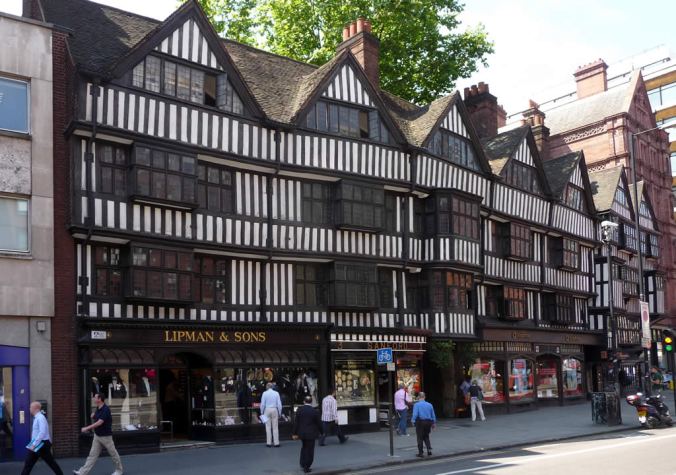
Staple Inn, opposite Chancery Lane station on High Holborn. Staple Inn was an ‘Inn of Chancery’, which were to attorneys (solicitors) what the Inns of Court are to barristers. Neophyte barristers would first attend an Inn of Chancery to learn about writs and legal procedure. Staple Inn is one of the few non-royal, pre-1600 buildings in London.
King’s Serjeant Hindstone rises and says the matter cannot lie in custom because it is against reason. He says that in a recent writ of nativo habendo before the court, in which the defendant pleaded that it was a custom of London that if a villein resided peaceably in London for a year he will be free, the custom was held void inasmuch as it is contrary to reason and common law because villein is an inheritance. Equally, the custom in the instant case is against common right and in prejudice to others and should likewise be held to be void.
Serjeant Hindstone further says that even if it was good custom, it would not avail against the king. There are vills that hold the tolls of roads and bridges by custom, yet the king does not pay anything for his carriage on these roads and bridges, and so even if the custom were good, the king is not bound by it.
Our barrister responds that a devise justified by custom can have good commencement and be consistent with reason, and contrary to common law, and yet be valid. For example, in various parts of England the custom holds that widows be endowed with half the husband’s estate (rather than the usual one-third), and in some places is held to have as an estate for life the principal mansion house of the husband, and this custom is as well pleaded against the king as against a stranger.
King’s Serjeant Littleton responds that in respect of customs that are contrary to common law, such as ‘Borough English’ whereby the youngest son inherits, they will lie because they are reasonable; the youngest son inherits inasmuch as he is worse able to aid himself, and is as near in blood to the father as the eldest. By contrast, the custom pleaded by the defendant would mean that one can be robbed and his goods pledged, and he would have no legal remedy to secure their return. It is thus contrary to reason and distinguished from customs that are contrary to common law but justified by reason.
It is further distinguished by the fact of the plaintiff being king; if there is a custom of a vill that waifs and strays (lost animals) can be seized by the lord if not claimed within a year and a day, even if 20 years pass the king can take his horse because time does not run against the king (“Nullum tempus occurrit Regis”). Thus the intervening transactions relating to the jewels do not avail the defendant.
The Attorney-General, William Nottingham, now rises to speak. He says that the law could be, between common persons, as our barrister has said. However, where the king is a party it is otherwise. Where the king can demonstrate that such goods were once in his possession and not otherwise alienated, process will issue against any person who has secured physical possession without permission.
AG Nottingham then says that it is against reason that a stranger should have power to put his goods in pledge and that he should have no writ or remedy to effect a recovery.
The justices adjourn to deliberate. Shortly thereafter, they return to the chamber and Prysot CJCP (Chief Justice Common Pleas) gives the following judgment; “A thing cannot lie in custom unless the same thing be reasonable, and if it is reasonable, notwithstanding it be contrary to common law, yet it can lie well enough in custom. The custom pleaded is not reasonable”. The justices have ruled against Mr Eyre. The matter is remitted back to the Court of Exchequer, and Mr Eyre will have to return the jewels or face outlawry.
Building a practice
Our barrister is disappointed not to have prevailed, but feels satisfaction at having taken part in a case of such importance. By now the court proceedings in the hall are winding up and lawyers and litigants are dispersing. Our barrister’s work day is not over yet. If he is to secure new work, he must seek it out.
He leaves the Palace of Westminster, walking through Whitehall, up Strand and back into the City of London. Stopping momentarily to purchase a joint of mutton to gnaw on, he makes his way to the parvis of St Paul’s (the steps fronting the entrance of the cathedral).
The parvis of St Paul’s is where barristers tout for business. The churchyard of the cathedral, also known as St Paul’s Cross, is a very busy place. It is the place at which royal proclamations are made. Heretical books, and sometimes Lollards, are burned in the Cross. Itinerant friars preach here, and people gather for public debates. It is like a medieval London cross between Piccadilly Circus and Speakers Corner at Hyde Park.
If barristers need to meet with a client or attorney for a con, they have space inside the cathedral where they can sit, take notes and dispose of legal business.
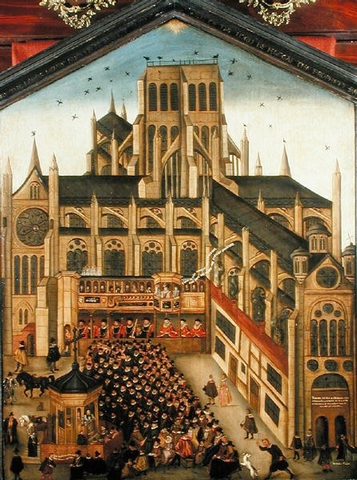
St Paul’s Cross
At the Cross, our barrister sees the attorney of the Worshipful Company of Mercers. The Mercers have regularly instructed him on livery company business, and he makes his way through the crowd to engage him. The attorney informs him that the widow of the former Master of the company has taken possession of one of the Company’s wharves at Queenhithe. The widow is claiming that fee simple title to the wharf was sold to the master and devised to feoffees who hold it to her use. Each time the Mercers have sent their servants to take possession of the wharf, the widow’s henchmen have beaten them up and driven them off the docks.
Our barrister determines that the first step is to secure copies of the conveyances that record the sale, if they indeed exist. If they do not, then a writ of novel disseisin can quite simply be issued in the Common Pleas against the widow and the feoffees-to-use. He sends his pupil to the Rolls House on Chancery Lane to do some research in the archives and attempt to find the Feet of Fine registering the ownership of the wharf.
After a day of toil and industry in the courts and at the cross, our barrister can return to the Temple for dinner (lunch) and an afternoon of mooting, legal readings, dancing and mirth.
Legal education
At 2pm, the Master of the Temple orders a cannon shot be discharged to let the benchers, serjeants and apprentices know it is time to eat. They return to Inner Temple hall, the benchers and any distinguished visitors sitting at high table.
Malmsey wine and venison pasties are served to the benchers and apprentices while the students sing, dance and perform plays to entertain them. Attendance is compulsory and the Butler will search the grounds of the Inn to make sure the students are not eating in their rooms, although a student who makes it to the buttery cannot be forcibly brought to the hall for it has been ajudged sanctuary since time immemorial.
Other dishes like roast beef and boar’s head are served to the assembled members. It is likely our barrister will be sitting at the same table as those he appeared opposite in the Exchequer Chamber, and it is an opportunity to discuss the case and its implications for the practice of money-lending in the City.
At this point, the Master poses a legal question, whether the king can by letters patent grant the wardship of the heir of a tenant-in-chief before the tenant is deceased, and the students divide into teams to moot the question as if before a court. The benchers interject awkward and difficult questions, and then decide who has won.
Once cheese is served, the students are excused from their entertaining and mooting duties and are now free to eat. After dinner, our barrister can repair to the library to do some research about the legal status of self-dealing transactions by the officers of corporations and livery companies. He might seek advice from other barristers in the library on that point, or give advice to his pupil on how to find relevant documents at the Rolls House.
His day ends with the Vespers service in the Temple Church and a modest supper in the hall with his comrades, and then returns to chambers for some light reading by candle-light, and bed.
Back in 2018
With this ‘day in the life’, it’s possible to see from whence came the singular traditions of the bar, such as qualifying sessions, pupillage, moots and its collective character. There have been calls for such traditions to abolished and for the legal profession to be fused. In my opinion, this would be a grave error.
Just like the special apparel of the bar, these traditions confer a special sense of identity and belonging to its members. If the bar’s contribution to the rule of law is partly a function of its independence, then maintaining those practices that set it apart and give it a unique sense of identity and tradition are to be applauded rather than swept away in the name of eliminating heterogeneity and making it less ‘stuffy’ and ‘intimidating’.
There is no other country on earth that possesses a system of legal qualification and practise akin to the English bar and Inns of Court. This is a thing of value, not a vestigial embarrassment, and its continued existence should be supported and protected.
Thank you for that. Do read sometime The Common Lawyers of Pre-Reformation England (1983) by Eric Ives; and JH Baker on St Germain (Selden Society).
On a mooting point only, you understand, of the survival of the bar in 2018:the habits of the bar are a rare enclave of discrimination and exclusivity, which are ill-suited to modern society and to contemporary attitudes to justice. Discuss….
LikeLike
I completely disagree on the discrimination point. The Inns of Court are perhaps the only surviving medieval guilds in the world. And having this system of professional organisation by guilds encourages selfless behaviour, such as taking on pupils. It’s hard to imagine the bar without the Inns of Court, and certainly it would become a less interesting, less altruistic, profession.
LikeLike
Pingback: Weekly Notes: legal news from ICLR – 12 March 2018 - ICLR
Pingback: Four maidens, 8000 ducats: the Saga of Drapers’ Hall | Order of the Coif
Pingback: Babington v Venour (1465): Bankruptcy, ravishment and the Fleet Prison | Order of the Coif
Pingback: Was Edward VI’s Devise for the Succession lawful? | Order of the Coif
Pingback: An Inner Templar’s Christmas Carol | Order of the Coif